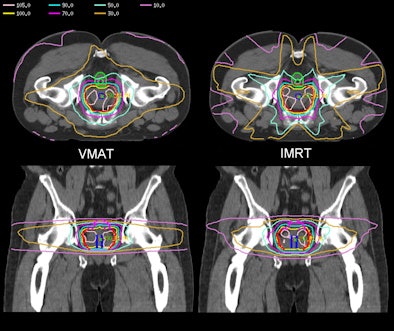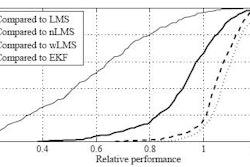
A study using volumetric modulated arc therapy (VMAT) for prostate cancer affirms the feasibility of the novel technique first published in the peer-reviewed journal Medical Physics earlier this year by Karl Otto, Ph.D., a medical physicist at the BC Cancer Agency in Vancouver, British Columbia.
In intensity-modulated radiation therapy (IMRT), a linear particle accelerator sweeps a 1- to 2-cm-wide beam of radiation across the tumor from five to nine angles around the patient, one angle at a time. In contrast, the VMAT method delivers radiation in a single 360° arc while the beam aperture shape continuously changes. Because the resulting beam apertures are much larger in VMAT than in IMRT, treatment time and patient exposure to radiation leakage from the accelerator are reduced.
Results from a VMAT technique similar to the one developed by Otto were presented at the American Association of Physicists in Medicine (AAPM) meeting in Houston by Pengpeng Zhang, Ph.D., of the department of medical physics at Memorial Sloan-Kettering Cancer Center in New York City.
Zhang and colleagues compared the VMAT technique with standard IMRT using retrospective data from five patients who were prescribed a dose of 86.4 Gy for prostate cancer.
They reported that the VMAT method reduced beam-on time by 50%, down to 2.5 minutes compared with IMRT's typical time of five minutes, with a corresponding reduction in the amount of dose leakage to healthy tissues. Other differences in the treatment plans and outcomes were negligible, Zhang said.
 |
"The main advantage VMAT has over IMRT is that it reduces the monitor unit by 49.8%, and secondary scatter dose to the patient is reduced accordingly," Zhang said.
"There are three mechanical axes during VMAT: gantry rotation, [multileaf collimator (MLC)] aperture shaping, and dose rate modulation," Zhang said. "During gantry rotation, both MLC aperture and dose rate are modulated according to the designed treatment plans. At a certain beam angle, if the required dose is too high and cannot be handled by dose rate modulation, the gantry will slow down to compensate dose delivery."
The Sloan-Kettering team's method included some refinements to the VMAT system developed by Otto and Palo Alto, CA-based Varian Medical Systems. Otto's VMAT method utilizes a modified Varian Trilogy linear accelerator called RapidArc. Zhang and colleagues, who also are consulting with Varian on a modified IMRT system, added a computer program that adjusts the aperture shape and radiation dose of each beam to maximize the radiation to the tumor while reducing exposure to healthy tissues. Zhang's method also breaks the arc into 360 evenly divided beams.
Zhang suggested that the VMAT technique also could be applied to more efficient treatment of other cancers in the future, such as head and neck, brain, and pelvis.
By Kathlyn Stone
AuntMinnie.com contributing writer
October 31, 2008
Copyright © 2008 AuntMinnie.com



















